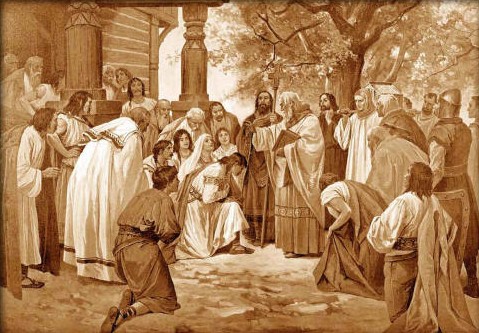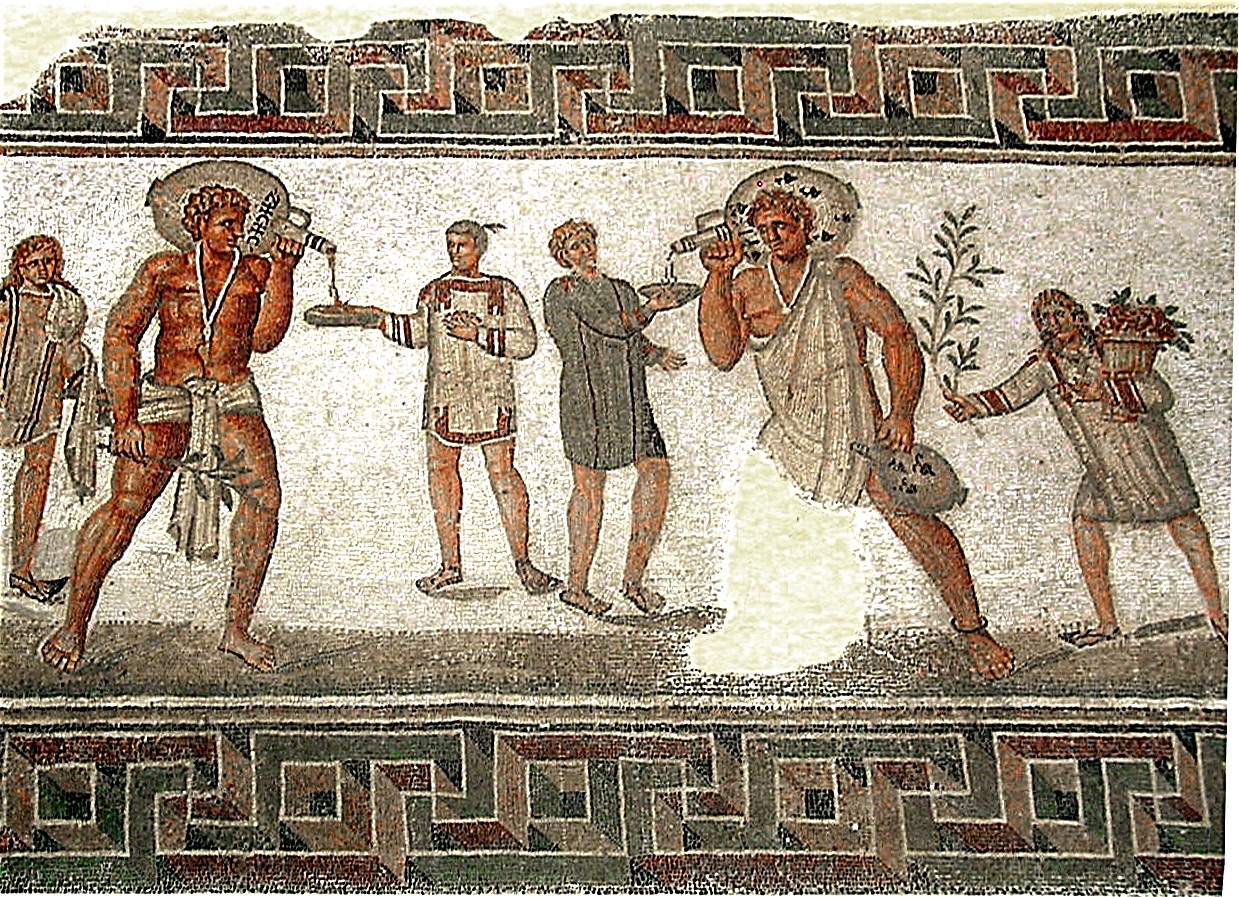|
Lampadarios
A lampadarius, plural ''Lampadarii'', from the Latin ''lampada'', from Ancient Greek "lampas" λαμπάς (candle), was a slave who carried torches before consuls, emperors and other officials of high dignity both during the later Roman Republic and under the Empire. ''Lampadarios'' in the post-Byzantine period designates the leader of the second (left) choir of singers in the Eastern Orthodox church practice. Lampadarius in Christianity There seems no special reason to attribute to the lampadarii any ecclesiastical character, though their functions were imitated by the acolytes and other clerics who preceded the bishop or celebrant, carrying torches in their hands, in the solemn procession to the altar and in other processions. There is very little evidence that any strictly liturgical use was made of lamps in the early centuries of Christianity. The fact that many of the services took place at night, and that after the lapse of a generation or two the meetings of the Christia ... [...More Info...] [...Related Items...] OR: [Wikipedia] [Google] [Baidu] |
Cantor (church)
In Christianity, the cantor, sometimes called the precentor or the protopsaltes (; from ), is the chief singer, and usually instructor, employed at a church, with responsibilities for the choir and the preparation of the Mass or worship service. Generally, a cantor must be competent to choose and conduct the vocals for the choir, to start any chant on demand, and to be able to identify and correct the missteps of singers placed under them. A cantor may be held accountable for the immediate rendering of the music, showing the course of the melody by movements of the hand(s) (''cheironomia''), similar to a conductor. Western Christianity Roman Catholicism Before and after the Second Vatican Council, a ''cantor'' in the Roman Catholic Church was the leading singer of the choir, a ''bona fide'' clerical role. The medieval cantor of the papal Schola Cantorum was called ''Prior scholae'' or ''Primicerius''. In medieval cathedrals, the cantor or precentor directed the music and ... [...More Info...] [...Related Items...] OR: [Wikipedia] [Google] [Baidu] |
Latin
Latin (, or , ) is a classical language belonging to the Italic branch of the Indo-European languages. Latin was originally a dialect spoken in the lower Tiber area (then known as Latium) around present-day Rome, but through the power of the Roman Republic it became the dominant language in the Italian region and subsequently throughout the Roman Empire. Even after the fall of Western Rome, Latin remained the common language of international communication, science, scholarship and academia in Europe until well into the 18th century, when other regional vernaculars (including its own descendants, the Romance languages) supplanted it in common academic and political usage, and it eventually became a dead language in the modern linguistic definition. Latin is a highly inflected language, with three distinct genders (masculine, feminine, and neuter), six or seven noun cases (nominative, accusative, genitive, dative, ablative, and vocative), five declensions, four verb conjuga ... [...More Info...] [...Related Items...] OR: [Wikipedia] [Google] [Baidu] |
Catacombs
Catacombs are man-made subterranean passageways for religious practice. Any chamber used as a burial place is a catacomb, although the word is most commonly associated with the Roman Empire. Etymology and history The first place to be referred to as ''catacombs'' was the system of underground tombs between the 2nd and 3rd milestones of the Appian Way in Rome, where the bodies of the apostles Peter and Paul, among others, were said to have been buried. The name of that place in Late Latin was L.L. fem. nom. pl. n. ''catacumbas'' (sing. ''catacumba'') a word of obscure origin, possibly deriving from a proper name or a derivation of the Latin phrase ''catatumbas'', "among the tombs". The word referred originally only to the Roman catacombs, but was extended by 1836 to refer to any subterranean receptacle of the dead, as in the 18th-century Paris catacombs. The ancient Christians carved the first catacombs from soft tufa rock. (ref)" (World Book Encyclopedia, page 296) All Roman ca ... [...More Info...] [...Related Items...] OR: [Wikipedia] [Google] [Baidu] |
Byzantine Music
Byzantine music (Greek: Βυζαντινή μουσική) is the music of the Byzantine Empire. Originally it consisted of songs and hymns composed to Greek texts used for courtly ceremonials, during festivals, or as paraliturgical and liturgical music. The ecclesiastical forms of Byzantine music are the best known forms today, because different Orthodox traditions still identify with the heritage of Byzantine music, when their cantors sing monodic chant out of the traditional chant books such as the Sticherarion, which in fact consisted of five books, and the Irmologion. Byzantine music did not disappear after the fall of Constantinople. Its traditions continued under the Patriarch of Constantinople, who after the Ottoman conquest in 1453 was granted administrative responsibilities over all Eastern Orthodox Christians in the Ottoman Empire. During the decline of the Ottoman Empire in the 19th century, burgeoning splinter nations in the Balkans declared autonomy or autocephaly fr ... [...More Info...] [...Related Items...] OR: [Wikipedia] [Google] [Baidu] |
Christianity In The Middle Ages
Christianity in the Middle Ages covers the history of Christianity from the fall of the Western Roman Empire (). The end of the period is variously defined. Depending on the context, events such as the conquest of Constantinople by the Ottoman Empire in 1453, Christopher Columbus's first voyage to the Americas in 1492, or the Protestant Reformation in 1517 are sometimes used.Davies ''Europe'' pp. 291–293 In Christianity's ancient Pentarchy, five patriarchies held special eminence: the sees of Rome, Constantinople, Jerusalem, Antioch, and Alexandria. The prestige of most of these sees depended in part on their apostolic founders, or in the case of Byzantium/Constantinople, that it was the new seat of the continuing Eastern Roman, or Byzantine Empire. These bishops considered themselves the successors of those apostles.Woollcombe, K.J. "The Ministry and the Order of the Church in the Works of the Fathers" in ''The Historic Episcopate''. Kenneth M. Carey (Ed.). Dacre Press (1 ... [...More Info...] [...Related Items...] OR: [Wikipedia] [Google] [Baidu] |
Slavery In Ancient Rome
Slavery in ancient Rome played an important role in society and the economy. Besides manual labour, slaves performed many domestic services and might be employed at highly skilled jobs and professions. Accountants and physicians were often slaves. Slaves of Greek origin in particular might be highly educated. Unskilled slaves, or those sentenced to slavery as punishment, worked on farms, in mines, and at mills. Slaves were considered property under Roman law and had no legal personhood. Most slaves would never be freed. Unlike Roman citizens, they could be subjected to corporal punishment, sexual exploitation (prostitutes were often slaves), torture and summary execution. Over time, however, slaves gained increased legal protection, including the right to file complaints against their masters. One major source of slaves had been Roman military expansion during the Republic. The use of former enemy soldiers as slaves led perhaps inevitably to a series of ''en masse'' armed rebel ... [...More Info...] [...Related Items...] OR: [Wikipedia] [Google] [Baidu] |
Ecumenical Patriarchate Of Constantinople
The Ecumenical Patriarchate of Constantinople ( el, Οἰκουμενικὸν Πατριαρχεῖον Κωνσταντινουπόλεως, translit=Oikoumenikón Patriarkhíon Konstantinoupóleos, ; la, Patriarchatus Oecumenicus Constantinopolitanus; tr, Rum Ortodoks Patrikhanesi, İstanbul Ekümenik Patrikhanesi, "Roman Orthodox Patriarchate, Ecumenical Patriarchate") is one of the fifteen to seventeen autocephalous churches (or "jurisdictions") that together compose the Eastern Orthodox Church. It is headed by the Ecumenical Patriarch of Constantinople, currently Bartholomew, Archbishop of Constantinople. Because of its historical location as the capital of the former Eastern Roman (Byzantine) Empire and its role as the mother church of most modern Orthodox churches, Constantinople holds a special place of honor within Orthodoxy and serves as the seat for the Ecumenical Patriarch, who enjoys the status of '' primus inter pares'' (first among equals) among the world's E ... [...More Info...] [...Related Items...] OR: [Wikipedia] [Google] [Baidu] |
Caeremoniale Episcoporum
The ''Cæremoniale Episcoporum'' (Ceremonial of Bishops) is a book that describes the church services to be performed by bishops of the Latin Church of the Catholic Church. History Pope Clement VIII published on 14 July 1600 the first book to bear this name, a revision, in line with the renewal ordered by the Council of Trent, of the contents of books, called ''Ordines Romani'', written from the end of the seventh century on to describe the ceremonies for the election and ordination of a Pope and to give indications for Mass and other celebrations by the Pope in the course of the year. The contents of these books were enriched over time. A work in two sections that became known as ''De Cæremoniis Cardinalium et Episcoporum in eorum diœcesibus'' (Ceremonies of Cardinals and Bishops in Their Own Dioceses) was added in the sixteenth century. Pope Clement VIII's ''Cæremoniale Episcoporum'' was based on these texts and on others that have now been lost. The work of preparation, begun ... [...More Info...] [...Related Items...] OR: [Wikipedia] [Google] [Baidu] |
Walter Of Coventry
Walter of Coventry ( fl. 1290), English monk and chronicler, who was apparently connected with a religious house in the province of York, is known to us only through the historical compilation which bears his name, the ''Memoriale fratris Walteri de Coventria''. The word ''Memoriale'' is usually taken to mean "commonplace book." Some critics interpret it in the sense of "a souvenir," and argue that Walter was not the author but merely the donor of the book; but the weight of authority is against this view. The author of the ''Memoriale'' lived in the reign of Edward I, and mentions the homage done to Edward as overlord of Scotland (1291). Since the main narrative extends only to 1225, the ''Memoriale'' is emphatically a second-hand production. But for the years 1201-1225 it is a faithful transcript of a contemporary chronicle, the work of a Barnwell canon. A complete text of the Barnwell chronicle is preserved in the College of Arms' (Heralds' College, manuscript 10) but has ne ... [...More Info...] [...Related Items...] OR: [Wikipedia] [Google] [Baidu] |
Holy Grail
The Holy Grail (french: Saint Graal, br, Graal Santel, cy, Greal Sanctaidd, kw, Gral) is a treasure that serves as an important motif in Arthurian literature. Various traditions describe the Holy Grail as a cup, dish, or stone with miraculous healing powers, sometimes providing eternal youth or sustenance in infinite abundance, often guarded in the custody of the Fisher King and located in the hidden Grail castle. By analogy, any elusive object or goal of great significance may be perceived as a "holy grail" by those seeking such. A "grail" (Old French: ''graal'' or ''greal''), wondrous but not unequivocally holy, first appears in ''Perceval, the Story of the Grail'', an unfinished chivalric romance written by Chrétien de Troyes around 1190. Chrétien's story inspired many continuations, translators and interpreters in the later-12th and early-13th centuries, including Wolfram von Eschenbach, who perceived the Grail as a stone. The Christian, Celtic or possibly other orig ... [...More Info...] [...Related Items...] OR: [Wikipedia] [Google] [Baidu] |
Alfred The Great
Alfred the Great (alt. Ælfred 848/849 – 26 October 899) was King of the West Saxons from 871 to 886, and King of the Anglo-Saxons from 886 until his death in 899. He was the youngest son of King Æthelwulf and his first wife Osburh, who both died when Alfred was young. Three of Alfred's brothers, Æthelbald, Æthelberht and Æthelred, reigned in turn before him. Under Alfred's rule, considerable administrative and military reforms were introduced, prompting lasting change in England. After ascending the throne, Alfred spent several years fighting Viking invasions. He won a decisive victory in the Battle of Edington in 878 and made an agreement with the Vikings, dividing England between Anglo-Saxon territory and the Viking-ruled Danelaw, composed of northern England, the north-east Midlands and East Anglia. Alfred also oversaw the conversion of Viking leader Guthrum to Christianity. He defended his kingdom against the Viking attempt at conquest, becoming the dominant ruler ... [...More Info...] [...Related Items...] OR: [Wikipedia] [Google] [Baidu] |


.jpg)




